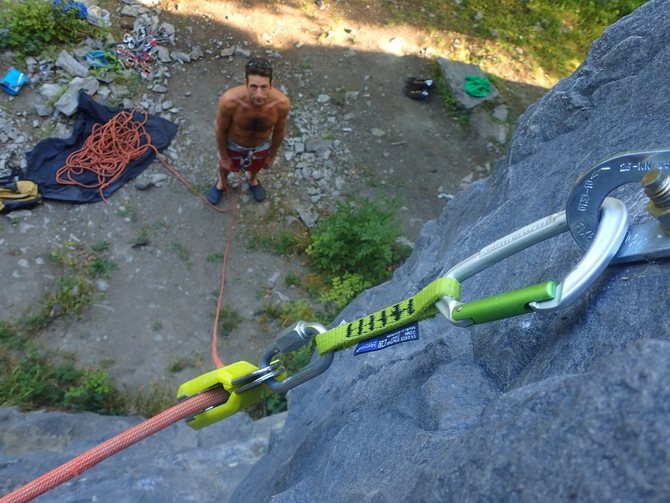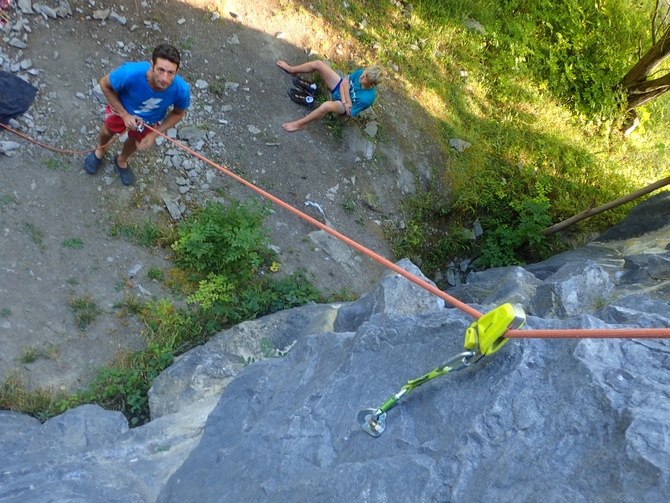Edelrid OHM - Assisted Braking Device
4th Sep 2018
I'm a big guy. I'm well used to being belayed by people who are lighter than me and have had my share of exciting falls / drops in my time. I now also have two boys who climb. They are both blessed with being incredibly light which makes for great endurance, but means I have to wait a few more years before they can belay me safely, even when tied down.
When I heard about the OHM (disappointingly I was hoping it was an acronym for something, but alas it appears not to be - perhaps the Overweight Hero Manager?) from Edelrid my interest was most definitely piqued.
Here's what Edelrid say about it:
Belayer requires significantly less hand braking force to arrest a fall
Lowering a heavier climber is much easier to control
OHM is attached at the first bolt in the safety chain
Should a lead climber fall at the first bolt, the OHM significantly reduces the risk of a possible ground fall
Rope handling when belaying a lead climber not affected (no additional friction when paying out rope)
Recommended weight difference (lead climber > belayer): 10 - 40 kg
Minimum weight belayer: 40 kg
For single ropes from 8.9 - 11 mm
Essentially it's a rather chunky piece of metalwork which you substitute for the first quickdraw on a sport route, passing the rope through it, which does all the things detailed in the list above. It looks a little like a cross between a quickdraw and a belay device, with the clever bit on one end attached by means of a maillon to a short tape, which in turn is attached to a snaplink karibiner. There's a small plastic lever on the device end which allows it to be folded open like a GriGri. The rope is then laid between the two halves, orientated according to the picture on the outside face, before it is closed over the end of the maillon. Note that there is no need to unscrew the maillon, it simply serves as an idiot proof karibiner. The tape gives the whole thing room to move and be pulled in different directions, and the snaplink is clipped into the first bolt on a route. Although it's possible to open, thread, close and clip whilst you are on the route I have found that it's easier to do all this whilst on the floor, setting off with a short loop of rope already threaded through the device on your harness, and clipping as you go past. From an operational point of view that's all there is to it!
In use it has proved to be completely amazing, though with one caveat. I have taken it out with my boys and my brother. We have each taken turns to both lead climb and belay using it, in combination with a GriGri. I weigh 85kg, my oldest son, who is 12, weighs 40kg. With my brother on hand as safety officer I was able to take repeated falls with my lad belaying, barely moving him with the impact. The limiting factor was the fact that he is 12 and obviously inexperienced at belaying, not the weight differential. We tested it out on a selection of sport routes, some steep and some less so. It was on the super steep Rubicon where we encountered our only issues with the device which, once it had been 'activated' - i.e. we had carried out a test fall - because of the steepness, and the angle that the rope passed through the device, it was reluctant to 'let go' of the rope and the climber was forced to pull the rope harder than they would do otherwise. Moving about to lessen the angle obviously helped. Aside from the steep Rubicon it made no difference whatsoever to the climbing experience, we just pulled the rope through to clip when necessary, and dragged the rope without resistance the rest of the time. Lowering off was a steady controlled affair with no jerking, and a modicum of additional friction resulting in a slower and more controlled lower.


My lad asked me why it is so heavy (it weights 470g which is pretty hefty for a single piece of kit and compares with the lightest quickdraws that Edelrid do at around 60g each!). I don't have an official explanation for this other than agreeing with the post on this UKC forum thread which posits that it is to absorb the energy, as heat, that would otherwise lift the belayer off the ground. The thread also addresses quite a few other questions about the device and is well worth a read.
When to use it seems to be a common question. It is designed for sport climbing as it requires a multi directional anchor which can only really be guaranteed by a bolt. It also is designed for ropes between 8.9mm and 11mm, so not suitable for skinny half ropes less than 8.9mm.
I'd question the need to use it when the lead climber is a lot lighter than the belayer and a softer, perhaps even dynamic belay is required, but we haven't yet tested this out.
It'll be interesting to see whether climbing walls adopt it as a safety device on their indoor routes. Stories abound of belayers being pulled up to the first quickdraw and lead climbers falling further as a result so there is a strong argument for it. To answer this question I just spoke to Dave Douglas, owner of Awesome Walls which ave climbing walls in Sheffield, Stockport, Liverpool, Stoke, Dublin and Cork. Dave has tested the device and is considering having some for hire at his walls he was so impressed. I asked whether, if I were to arrive at the wall in Sheffield with one, would I be able to use it. His answer was encouraging. As long as I could demonstrate that I was competent enough to use it this would be allowed. We'd simply clip it to the bolt beneath the in-situ maillon of the first quickdraw. Essentially as it is not a belay device, it can't really be used incorrectly so doesn't pose a safety risk at the wall. As to whether it will do what I had first hoped, and mean that I can go climbing with my boys without an adult present, our testing has proven that they need more belay practice first. Dave confirmed that climbing walls won't lower the minimum belaying age from 14 on the grounds that young kids aren't guaranteed to be mature enough to cope with the responsibility of belaying. As a family we'll be taking it step by step, but I can safely say that the OHM is a very welcome addition and well worth the relatively high price tag. It retails for around £108, but is available for significantly less if you shop around.
More info on the Edelrid website.
Here's a video of my brother testing it out with my lad belaying.
